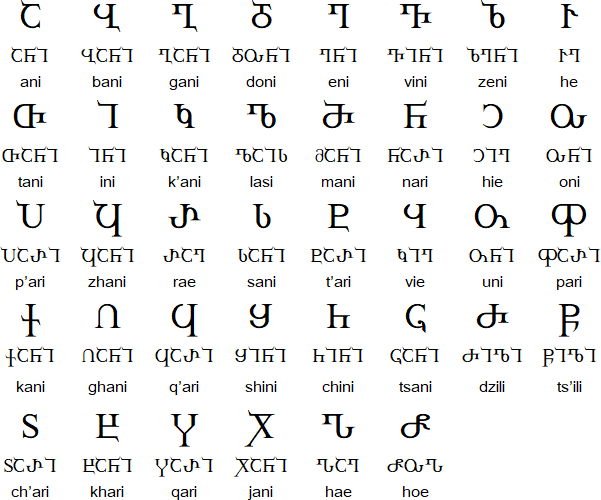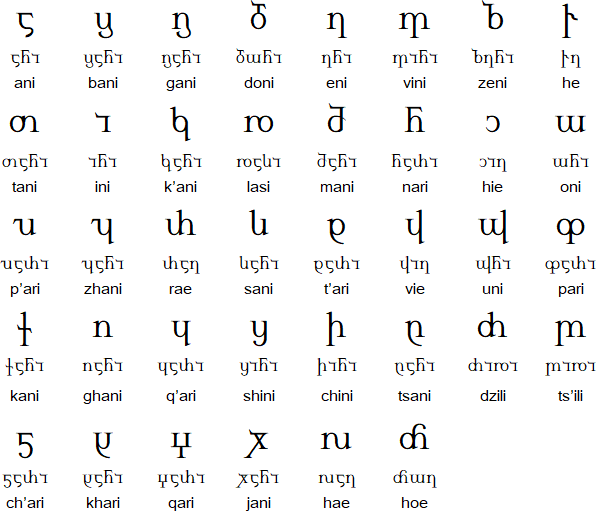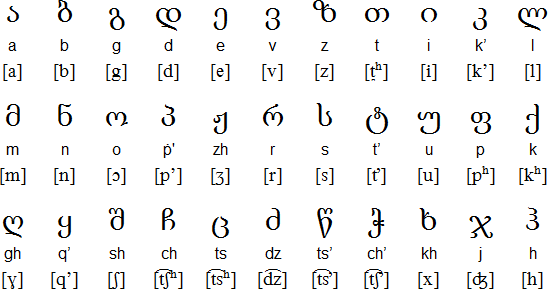The Georgian language reflects the character and growth of the nation
The Georgian language (Kartuli ena) has developed around the unique heritage of Georgia’s people. The official language of Georgia, it is spoken by nearly four million people as a first or second language.
Georgian belongs to the languages of the Caucasus, a cluster of tongues which have been spoken in the Caucasus Mountains region for millennia. Three language groups comprise the Caucasus languages: Abkhazo-Adyghian (Northwest Caucasian), Nakho-Dagestanian (Northeast Caucasian) and Kartvelian (South Caucasian). Georgian, along with the Mingrelian, Laz and Svan languages, belongs to the Kartvelian language family.
The history of the Georgian language stretches back to the BC era and encompasses a prolific literary heritage. Considered one of the oldest languages in the world, it has managed to retain much of its original alphabet and pronunciation despite the passing of centuries.
According to linguists, spoken Georgian predates its written form, and evidence of its ancient roots remains strewn throughout the present-day dialect. Verb morphology and vocabulary words such as es mkerdi (chest), tbili (warm) and ekvsi (six) suggest links to an Indo-European dialect. The earliest surviving reference to the Georgian language is found in a 2nd-century passage written by Roman orator Marcus Cornelius Fronto, who remarked that the Iberians of present-day eastern Georgia spoke with Emperor Marcus Aurelius in an "incomprehensible tongue".
The formation of the Georgian script is ascribed to King Parnavaz, a 3rd-century BC Iberian ruler, yet the earliest extant printing of the Georgian alphabet, found on a tablet in Palestine, dates to 430 AD and is written in the Asomtavruli alphabet (see below). A comparison of this slab with another stone dating to 493 AD reveals that slight variations in the letters had already transpired over this 60-year period. The oldest surviving Georgian text is a 5th- century AD biography by Jakob Tsurtaveli entitled Martyrdom of Saint Shushanik the Queen. The first book to be printed in the Georgian language was a Georgian-Italian dictionary published in Rome in 1629. The dictionary also included a printing of the Georgian alphabet and a collection of prayers. In 1709, a European-style printing house opened in Tbilisi and began to publish both educational and religious books.
Formational Stages of the Georgian Script
The Georgian language alphabet has undergone three major transformations over the centuries:
Asomtavruli (ასომთავრული)
The Asomtavruli script, the first written form of the Georgian language, was used from approximately the 5th to the 9th centuries:

Nuskhuri (ნუსხური)
During the 9th century, Asomtavruli (meaning “capital letters”) was gradually replaced by a more angular alphabet known as Nuskhuri (meaning “lowercase"), which was used until the 11th century:

Mkhedruli (მხედრული)
The Mkhedruli script, whose name is derived from the word mkhedari (equestrian), developed from Nuskhuri between the 11th and 13th centuries. Initially, the new alphabet was utilized only for non-religious texts. Over time, however, Nuskhuri evolved into the primary script for religious texts and Asomtavruli was used in a much more limited scope. With time, the two original alphabets grew obsolete and Mkhedruli alone was used by the Georgian people.
The Georgian alphabet has undergone relatively few changes since the Middle Ages, with the exception of a few letters added and removed in the 18th-19th centuries. Currently, the alphabet stands as such:

Features of the Georgian Language
Due to its unique vocabulary and intricate makeup, Georgian is often considered a very difficult language to learn, yet understanding its basic structure can prove helpful for anyone who wishes to learn the Georgian language.
The modern Georgian alphabet has 33 letters comprised of 5 vowels and 28 consonants. It is read from left to write and contains no capital letters, articles or grammatical gender. Georgian is characterized by multiple consonants and consonant clusters, particularly at the beginning of words where up to six consonants can occur consecutively, e.g., tkven (you), zghva (sea) and mtsrtneli (trainer).
The accepted word order in Georgian is Subject-Object-Verb (SOV), although this can vary depending on the context: Is skolashi midis – He goes to school.
Perhaps the greatest difficulty imposed by Georgian is its agglutinative verbs, whose numerous prefixes and suffixes are used to indicate tense, subject and object:
Darekva – Call
Vrekav – I call/I am calling
Damireke – Give me a call (you)
Damireka – He/she called me
Mirekavs – He/she calls me
The Georgian language has at least 18 dialects which retain unique morphological, syntactical, lexical and phonological features. For example, in the mountain regions of Kazbegi, Khevsureti and Tusheti, people use unusual expressions and word forms which are uncommon in other parts of the country. As accents and terminology are unique in every region, it is fairly easy to distinguish from which part of Georgia a person originates. The other Kartvelian languages - Mengrelian, Svan and Laz - are spoken primarily in western Georgia, and Laz is also spoken by small communities in Turkey.
Historically, Georgia was a part of the Arab, Ottoman, Persian and Russian empires, which explains why the Georgian language has many loan words from Turkish, Persian, Arabic and Russian. The standard greeting in Georgian, “Gamarjoba!”, has a close connection with the word gamarjveba, meaning “victory”, and reflects the country’s complicated past of seemingly endless battles and attacks. Like gamarjoba, “Good morning/evening” in Georgian is “Dila/Saghamo mshvidobisa”, or “Morning/Evening of peace”.
It is interesting to note that the Georgian language has three separate words for ‘yes’ and only one word for ‘no’:
Diakh – Yes (formal)
Ki – Yes (informal)
Ho – Yes (coloquial)
Ara – No
Below are some common Georgian words and phrases:
| Hello | Gamarjoba |
| Goodbye | Nakhvamdis |
| I am sorry | Bodishi |
| Excuse me | Ukatsravad |
| Thank you | Gmadlobt (formal), Madloba(infomal) |
| Please | Tu sheidzleba |
| Yes | Diakh (formal), ki (informal) |
| No | Ara |
There is no better way to hone your Georgian language skills, delve deeper into its nuances and connect the dots between the local culture and language than with a visit to the country itself! Visiting Georgia will provide endless opportunities to appreciate the rich Georgian language and the people who call it their own.

